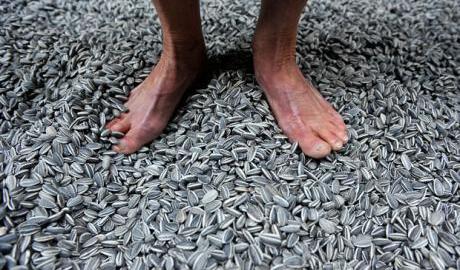Seeds of Destruction: Dustup at the Tate Modern

Art is good for the soul, but sometimes it can be bad for your health. Chinese artist Ai Weiwei’s Sunflower Seeds installation at the Tate Modern in London aroused curiosity before it began affecting visitors’ respiratory systems with the porcelain dust it threw off. Sadly, this is just the latest hazardous episode in the nine-year history of the Tate Modern’s “The Unilever Series” program of featuring installation art by the hottest contemporary artists. But are these blockbuster shows pushing the envelope beyond the limits of public safety?
Ai filled the Tate Modern’s Turbine Hall with 100 million porcelain seeds (picture above). Like snowflakes, no two seeds were identical thanks to hand-painted marks to make the seeds resemble actual sunflower seeds. Those seeds flooded the hall at a depth in which visitors could walk and even immerse themselves, like a grey beach of pellets. Unfortunately, after a few days of people waking through the seeds, many of them had been crushed to the point of becoming dust. Health and safety experts warned that prolonged exposure to the porcelain dust could worsen preexisting conditions such as asthma and even affect those who do not have breathing issues over time. Sunflower Seeds can now only be seen and not touched.
I understand and appreciate Ai’s intentions for Sunflower Seeds. The tactile nature of touching and even frolicking in the sea of seeds would have allowed visitors to engage with the work in a way that very few museum pieces permit. Before the dust became a concern, the Tate Modern worried more about theft of the seeds as people might want to take their experience home with them, although I seriously doubt that even rampant theft could put a dent in the 100-million-piece installation. Now all of that tactile, sensory feel is lost as visitors are relegated to looking from behind velvet ropes or from the bridge high above. The New York Times’ Roberta Smith suggests that the museum might now give away bags of the seeds to restore Ai’s original intent, but that seems too little, too late.
Amazingly, this isn’t the first or even the second installation-related incident at the Tate Modern. In 2006, some visitors were injured going down the giant slides of Carsten Höller‘s Test Site.The next year, Doris Salcedo’s Shibboleth introduced a giant crack into the floor of the Turbine Hall upon which 15 people tripped and were hurt in the first month alone. Although the crack wasn’t exactly a chasm, a small child could have conceivably fallen into the wider sections. Finally, just last year, Miroslaw Balka’s How It Is plunged visitors into almost total darkness, which resulted in at least one elderly patron accidentally walking into a wall and sustaining injury. Each one of these installations, like Ai’s Sunflower Seeds, offered visitors a physical experience, but somehow the physical turned dangerous.
Ironically for Ai, he’s gained international notice, and the ire of the Chinese government, for uncovering the corruption scandal surrounding improperly constructed schools that collapsed during the 2008 Sichuan earthquake. Ai’s no anarchist with little care of human life. In fact, Ai made sure that the porcelain seeds were not fired out of a concern that they’d be too slippery to walk on. Whether anyone could have foreseen the dust problem is unclear, but in retrospect it looks like an engineering blunder of epic (to the tune of 100 million mistakes) proportions.
This isn’t on the same scale as the unfortunate death in the early 1970s of a handler caused by one of Richard Serra’s mammoth metal sculptures. Serra actually builds in an element of danger, albeit technically safe, in his tilting metal plates that threaten to harm but never actually do. But the Tate Modern clearly needs to work with its artists to design engaging yet still safe pieces. Thrill-seekers might be drawn to tempt fate with such dangerous works, but dust-induced lung ailments and tripping over cracks seem a little lame for the bungee-jumping crowd. Modern art struggles enough to be taken seriously without such incidents confirming the cartoonish prejudices of the uninitiated. If you’re going to plant a seed in the minds of people viewing modern art, plant one that won’t hurt them in the process.





